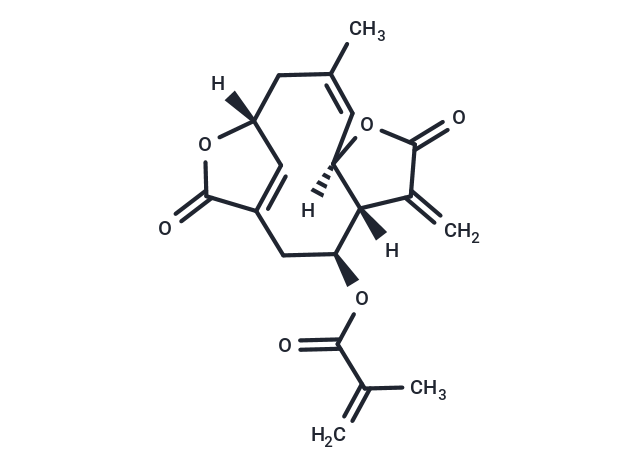Shopping Cart
- Remove All
 Your shopping cart is currently empty
Your shopping cart is currently empty

Deoxyelephantopin has anti-inflammatory, hepatoprotective, and wound healing activities; it also has antitumor activity.Deoxyelephantopin inhibits NF-κB, MAPK, PI3K/Akt, and β-catenin signaling

| Pack Size | Price | Availability | Quantity |
|---|---|---|---|
| 1 mg | 92 € | In Stock | |
| 5 mg | 234 € | In Stock | |
| 10 mg | 349 € | In Stock | |
| 25 mg | 566 € | In Stock | |
| 50 mg | 819 € | In Stock | |
| 1 mL x 10 mM (in DMSO) | 240 € | In Stock |
| Description | Deoxyelephantopin has anti-inflammatory, hepatoprotective, and wound healing activities; it also has antitumor activity.Deoxyelephantopin inhibits NF-κB, MAPK, PI3K/Akt, and β-catenin signaling |
| In vitro | Deoxyelephantopin was evaluated for its effects on the expression of mRNAs encoding CYP1A2, CYP2D6 and CYP3A4, and protein expression and resultant enzymatic activity. The mRNA and protein expression of cytochrome isoforms were carried out using an optimized multiplex qRT-PCR assay and Western blot analysis, respectively. Human CYP3A4 protein expression was determined using an optimized hCYP3A4-HepG2 cell-based assay and the enzymatic activity was evaluated using P450-Glo CYP3A4 assay. The molecular interaction and possible inhibition of Deoxyelephantopin of the CYP3A4 enzyme was determined in silico and further validated using substrate-specific CYP3A4 inhibition assays. Deoxyelephantopin produced no significant effect on the CYP1A2 and CYP2D6 mRNA and protein expression. However, it has a weak induction effect on CYP3A4 at the transcriptional level[1] |
| Molecular Weight | 344.36 |
| Formula | C19H20O6 |
| Cas No. | 29307-03-7 |
| Smiles | [H][C@@]12C\C(C)=C/[C@@]3([H])OC(=O)C(=C)[C@]3([H])[C@H](CC(=C1)C(=O)O2)OC(=O)C(C)=C |
| Relative Density. | 1.26g/cm3 |
| Storage | store at low temperature,keep away from moisture,keep away from direct sunlight | Powder: -20°C for 3 years | In solvent: -80°C for 1 year | Shipping with blue ice. | |||||||||||||||||||||||||||||||||||
| Solubility Information | DMSO: 100 mg/mL (290.39 mM), Sonication is recommended. | |||||||||||||||||||||||||||||||||||
Solution Preparation Table | ||||||||||||||||||||||||||||||||||||
DMSO
| ||||||||||||||||||||||||||||||||||||

Copyright © 2015-2024 TargetMol Chemicals Inc. All Rights Reserved.